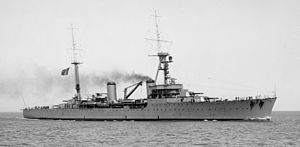French cruiser Tourville (1926)
Appearance
 Tourville in 1929
| |
| History | |
|---|---|
| Name | Tourville |
| Namesake | Anne Hilarion de Tourville |
| Builder | Lorient Navy Yard |
| Laid down | 14 April 1925 |
| Launched | 24 August 1926 |
| Commissioned | 1 December 1928 |
| Fate | Condemned 8 March 1962 |
| General characteristics | |
| Class and type | Template:Sclass- |
| Displacement |
|
| Length | 191 m (626 ft 8 in) overall |
| Beam | 19 m (62 ft 4 in) |
| Draught | 6.32 m (20 ft 9 in) |
| Propulsion | 4-shaft Rateau-Bretagne single-reduction geared turbines; 9 Guyot boilers; 120,000 shp (89 MW) |
| Speed | 33.75 knots (38.84 mph; 62.51 km/h) |
| Range | 4,500 nautical miles (5,200 mi; 8,300 km) at 15 knots (17 mph; 28 km/h) |
| Complement | 605 |
| Armament |
|
| Armour |
|
| Aircraft carried | 2 GL-812 (superseded by GL-832 then Loire-Nieuport 130, 1 catapult) |
Tourville was a French Template:Sclass- heavy cruiser that served during World War II. At the outbreak of the war, Tourville was part of the Force X, under Vice Admiral Godfroy.
Design and description
The design of the Duquesne class was derived from an enlarged version of the Template:Sclass- light cruiser armed with 203-millimetre (8 in) guns. The ships had an overall length of 191 meters (626 ft 8 in), a beam of 19 meters (62 ft 4 in), and a draft of 6.45 meters (21 ft 2 in). They displaced 10,160 metric tons (10,000 long tons) at standard load and 12,435 t (12,239 long tons) at deep load. Their crew normally consisted of 605 men and increased by 32 when serving as flagships.[1]
References
- ^ Jordan & Moulin, p. 44
Bibliography
- Jordan, John & Moulin, Jean (2013). French Cruisers 1922–1956. Barnsley, UK: Seaforth Publishing. ISBN 978-1-84832-133-5.
